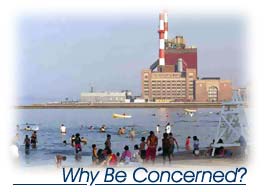|
 |
 |
Why Be Concerned

 |

|
|
| |
Air pollution is a problem for all of us. The average adult breathes
over 3,000 gallons of air every day. Children breathe even more
air per pound of body weight and are more susceptible to air pollution.
Air pollution threatens the health of human beings and other living
things on our planet. While often invisible, pollutants in the air
create smog and acid rain, cause cancer or other serious health
effects, diminish the protective ozone layer in the upper atmosphere,
and contribute to the potential for world climate change.
Listed below are issues affecting air quality, our health, and
the environment. To find out more about the issues, visit the links
provided. |
 
| | | "Acid rain" is a broad term describing
acid rain, snow, fog, and particles. It is caused by sulfur dioxide
and nitrogen oxides released by power plants, vehicles, and other
sources. Acid rain harms plants, animals, and fish, and erodes bulding
surfaces and national monuments. In addition, acidic particles can
hurt people's lungs and reduce how far we can see through the air.
|
 
| | | A protective ozone layer is located in
the stratosphere about 22 miles above the Earth's surface. This layer
protects us from the sun's harmful ultraviolet radiation. This protective
shield is being damaged by chemicals such as CFCs, halons, and methyl
chloroform, and can lead to harmful health effects such as skin cancer
and cataracts.
|
 
| | | Haze is caused when sunlight encounters
tiny pollution particles in the air. It degrades visibility in many
American cities and affects some of our nation's most treasured areas,
including Grand Canyon, Yellowstone, Acadia, and Shenandoah.
|
 
| | | Global warming refers to an average increase
in the Earth's temperature, which in turn causes changes in climate.
Rising global temperatures are expected to raise sea level, and change
precipitation and other local climate conditions. Changing regional
climate could alter forests, crop yields, and water supplies. It could
also threaten human health, and harm birds, fish, and many types of
ecosystems.
|
 
| | | Includes 188 hazardous air pollutants, such as benzene, methylene
chloride, mercury, and dioxins. Some are known or suspected to cause
cancer. Others may cause respiratory effects, birth defects, and reproductive
and other serious health effects. Some can even cause death or serious
injury if accidentally released in large amounts.
|
 
| | | Radiation occurs naturally (e.g. radon)
but we also use radioactive materials to generate electricity and
to diagnose and treat medical problems. Frequent exposures to radiation
can cause cancer and other adverse health effects, including genetic
defects in the children of exposed parents or mental retardation in
the children of mothers exposed during pregnancy.
|
 
| | | Indoor air levels of many pollutants
may be 2-5 times, and occasionally, more than 100 times higher than
outdoor levels. Indoor air pollutants are of particular concern because
most people spend as much as 90% of their time indoors. Common sources
can include burning kerosene, wood or oil, smoking tobacco products,
releases from household cleaners, pesticides, building materials,
and radon.
|
 
| | |
Breathing air pollution such as ozone (a primary ingredient
in urban smog), particulate matter, carbon monoxide, nitrogen
oxides, sulfur dioxide, and lead can have numerous effects on
human health, including respiratory problems, hospitalization
for heart or lung disease, and even premature death. Some can
also have effects on aquatic life, vegetation, and animals.
|
|
| |
|

